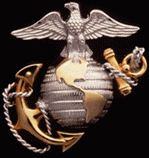



Marion Carl was born into a farming family in the Willamette Valley on 1 November 1915.
He graduated from Oregon State College in 1938 with an engineering degree.
He entered Navy flight training at Pensacola, having already soloed as a civilian after 2.5 hours dual instruction.
Commissioned in December 1939, he embarked upon a unique 34-year career during which he became
the Marine's first ace, the Corps' first qualified helicopter pilot, and the world record holder for altitude flight and speed.
His first combat came while with VMF-221 at Midway, when he shot down a Mitsubishi Zero during the battle of 4 June 1942.
Barely two months later he was part of the "Cactus Air Force" with MAJ John L. Smith's VMF-223 at Guadalcanal.
He left Cactus in October as the Corps' second-ranking ace with 16.5 victories, having been shot down once himself.
He took VMF-223 back to combat in 1943, and scored two more kills to finish seventh among 120 Leatherneck aces of WW II.
He received his star and took the 1st Brigade to South Vietnam in 1965.
While there, he flew combat missions in UH-1s, A-4s, F-4s and F-8s.
His aide, Lt. Lyle Prouse, fondly describes the combat-qualified general as "the last of the old-time warriors."
Prouse recalls that the general's attitude was one of "take care of your people and they'll take care of you."
Promoted to Major General in 1967, Carl commanded the 2nd Marine Air Wing at MCAS Cherry Point, N.C.,
and finished his career as Inspector General of the Marine Corps.
Marion Carl was laid to rest in Arlington National Cemetery on 9 July 1998.
Aside from his combat and flight test records, Marion Carl's legacy is one of extreme skill combined with rare modesty and concern for those entrusted to his care.
When he reported on board MCAS Valhalla, it became an even finer duty station.




